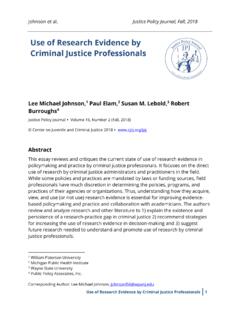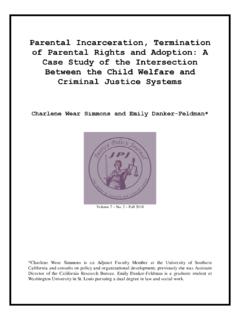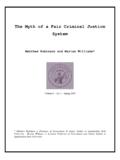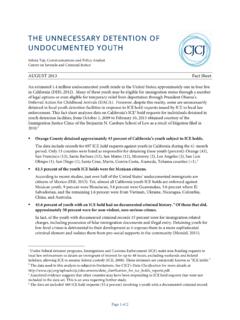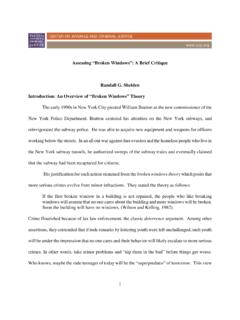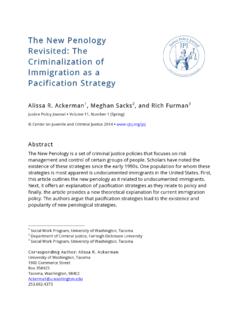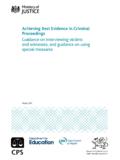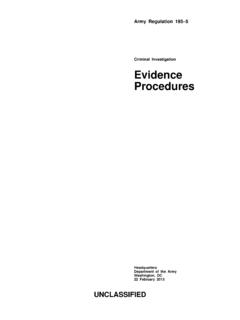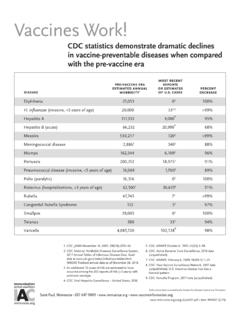Transcription of The History of the Pre-sentence Investigation Report
1 The History of the Pre-sentence Investigation Report Considered among the most important documents in the criminal justice field, the presentence Investigation Report (PSI) has been the central source of information to sentencing judges since the 1920s. Its original purpose was to provide information to the court on the defendant s personal History and criminal conduct in order to promote individualized sentencing. With the advent of more punitive sentencing policies in recent years, the PSI has become more offense focused and less individualized. Despite current trends, the PSI will likely remain a critical component of the American criminal justice system Origins of the PSI The origins of the modern presentence Investigation began in the 1840s with the crusading efforts of Boston shoemaker John Augustus (1841-1859).
2 It was Augustus belief that the "object of the law is to reform criminals and to prevent crime, and not to punish maliciously or from a spirit of revenge." In his efforts to redeem selected offenders, Augustus gathered background information about the offender s life and criminal History . If he determined that the person was worthy, Augustus provided bail money out of his own pocket. If he succeeded in winning the person s release, he helped them find employment and housing. Later he appeared at the sentencing hearing and provided the judge with a detailed Report of the person s performance. Augustus would then recommend that the judge suspend the sentence and release the person to his custody. Considered the father of modern probation, Augustus s leadership led the Massachusetts legislature to establish the nation s first probation law in 1878.
3 By authorizing the Mayor of Boston to appoint a member of the police department to serve as a paid probation officer, this statute formalized the practice of extending probation to "such persons as may be reasonably be expected to be reformed without punishment." The law was expanded in 1891 with the creation of an independent state-wide probation system. By the time that the National Probation Act was passed in 1925 creating a Federal probation service, the majority of states had probation statutes. The evolution of the presentence Investigation was given further impetus by the reformatory movement of the 1870s. Because reformatory movement proponents advocated an individualized approach towards the redemption of the criminal, indeterminate sentencing became a popular sentencing reform throughout the later half of CEN TER ON JUVEN ILE AN D CRIMIN AL JUSTICE w w w.
4 19th century and became the standard form of sentencing throughout the United States until the 1980s. Simultaneous to the development of probation and the indeterminate sentence, the evolution of the social sciences gave rise to the medical model of corrections during the 1920s and 1930s. The medical model was founded on the belief that crime was the result of individual pathology that could be diagnosed and treated like a disease. Judges simply needed to know the problem in order to prescribe treatment. As these systems and approaches evolved, the need for more information about the defendant became critical. By the 1930s, one of the primary tasks of probation officers throughout the country was the preparation of the presentence Investigation Report .
5 Content of the PSI Offender-based reports The traditional PSI was intended to provide the judge with comprehensive background information about the offender. Under this model, the PSI was intended to promote individualized sentencing by giving information specific to the offender s potential for rehabilitation and community reintegration and allow judges to tailor their sentence accordingly. The offender-based PSI is integral to a sentencing system founded on rehabilitation. The elements of an offender-based Report includes a summary of the offense, the offender s role, prior criminal justice involvement, and a social History with an emphasis on family History , employment, education, physical and mental health, financial condition and future prospects.
6 Based on this thorough background analysis, a probation officer renders a sentencing recommendation. In a 1978 publication by the Administrative Office of the United States Courts described the essential elements of a typical offender-based PSI: It specifies what the presentence Report shall contain, , "any prior criminal record of the defendant and such information about his characteristics affecting his behavior as may be helpful in imposing and such other information as may be required by the court In this type of PSI, little consideration is given to the offense or victim concerns. Instead, the primary role of the probation officer is to investigate the offender s background. Although standards differ from jurisdiction to jurisdiction, figure one is an outline of the Federal probation systems format for an offender-based PSI.
7 Elements of an Offender-Based presentence Report 1. Offense Official Version Defendant s Version Codefendant Information Statement of witnesses, complainants, and victims 2. Prior Record Juvenile adjudications Adult arrests Adult convictions 3. Personal and Family Data Defendant Parents and siblings Marital Education Employment Health Physical Mental and emotional Military services Financial condition Assets Liabilities 4. Evaluation Alternative Plans Sentencing Data 5. Recommendation Offense-based reports In recent years, as the indeterminate sentence and its rehabilitative ideal was replaced by the determinate sentencing and the punishment ideology, the PSI has undergone major transformations.
8 The primary purpose of determinate sentencing is not to rehabilitate, but to impose a predetermined range of fixed sentences . Determinate sentencing can take many forms - such as presumptive sentencing and guideline sentencing. Elements of an Offense-Based presentence Report 1. The offense Charge(s) and conviction(s) Related cases The offense conduct Adjustment for obstruction of justice Adjustment for acceptance of responsibility Offense level computation 2. The defendant s criminal History Juvenile Adjudications Criminal convictions Criminal History computation Other criminal conduct Pending charges (include if pertinent) 3. Sentencing options Custody Supervised release Probation 4. Offender characteristics Family ties, family responsibilities, and community ties Mental and emotional health Physical condition, including drug dependence and alcohol abuse Education and vocational skills Employment record 5.
9 Fines and restitution Statutory provisions Guidelines provisions for fines Defendant s ability to pay 6. Factors that may warrant departure (from sentence guidelines 7. The impact of plea agreement (if pertinent) 8. Sentencing recommendations offender characteristics fines and restitution factors that may warrant departure impact of the plea agreement sentencing recommendations Presumptive sentencing requires a judge to choose from a narrow range of statutorily mandated sentencing options. For example, when imposing a prison sentence under California s presumptive sentencing system, a judge must choose one of three potential periods of confinement. Periods of confinement might include two, four, or six years of imprisonment with the PSI providing information on the defendant s culpability.)
10 Decisions on culpability are based on the defendant s actions and motivations in carrying out the offense. If the defendant was a primary instigator who inflicted excessive harm or damage, an aggravated term would likely be justified. In contrast, a defendant who participated in the offense under duress and did not occupy a leadership role may be eligible for the mitigated term. Under this sentencing system the primary role of the probation officer in preparing the PSI is to determine the mitigated and aggravating circumstances that apply. Guideline sentencing further restricts the range of sentencing options by requiring judges to base their sentence on numerical formulas of offense severity and criminal History . The scores are calibrated on a sentencing grid, with judges given minimal discretion in deviating from the guidelines.
